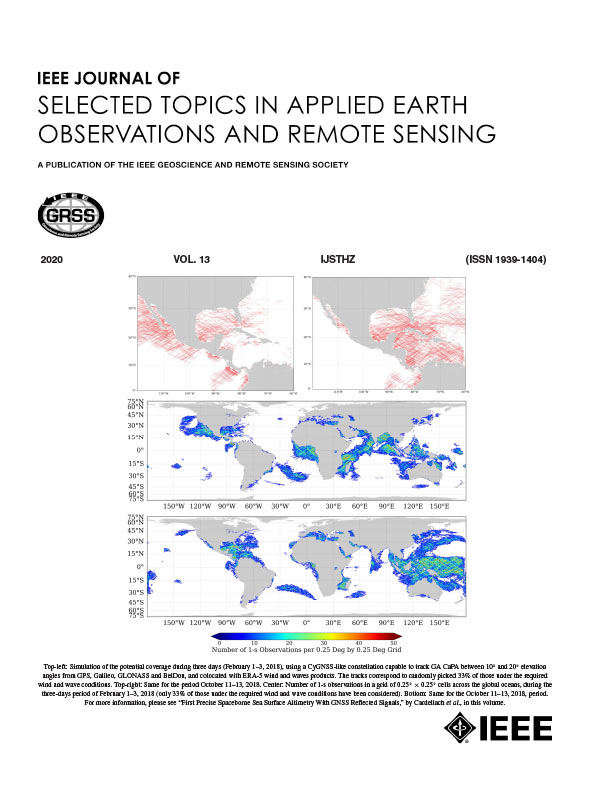Seasonal Dynamics in Land Surface Temperature in Response to Land Use Land Cover Changes Using Google Earth Engine
IF 4.7
2区 地球科学
Q1 ENGINEERING, ELECTRICAL & ELECTRONIC
IEEE Journal of Selected Topics in Applied Earth Observations and Remote Sensing
Pub Date : 2024-09-26
DOI:10.1109/JSTARS.2024.3466191
引用次数: 0
Abstract
Changes in land use and land cover (LULC) are critical for evaluating global spatiotemporal trends, especially regarding climate change and urbanization. This study investigates the dynamics of Landsat surface temperature (LST) in response to LULC changes and their effects on the seasonal microclimate in Kasur District, Pakistan. Using the Google Earth Engine platform, we employed a random forest algorithm to detect LULC changes (cropland, forest, built-up, fallow, barren, and water) and analyze seasonal spectral indices from Landsat imagery for 1988, 2002, and 2022. Significant LULC changes were observed, including a 9.8% increase in built-up areas, a 4.2% decrease in cropland, and a 1.4% decrease in forested areas, linked to urban heat island effects and population growth. Additionally, there was a 2.7% increase in fallow and open land, contributing to the district's impervious surface area. Significant correlations (利用谷歌地球引擎研究土地利用和土地覆盖变化对地表温度的季节动态影响
土地利用和土地覆盖(LULC)的变化对于评估全球时空趋势,尤其是气候变化和城市化趋势至关重要。本研究调查了陆地卫星表面温度(LST)随土地利用和土地覆盖变化的动态变化及其对巴基斯坦卡苏尔地区季节性小气候的影响。我们使用谷歌地球引擎平台,采用随机森林算法检测土地利用、土地利用变化(耕地、森林、建筑、休耕地、荒地和水),并分析 1988 年、2002 年和 2022 年大地遥感卫星图像的季节光谱指数。观察到土地利用、土地利用变化显著,包括建筑密集区增加了 9.8%,耕地减少了 4.2%,林地减少了 1.4%,这与城市热岛效应和人口增长有关。此外,休耕地和空地增加了 2.7%,增加了该地区的不透水面积。在冬季和夏季,LST 与光谱指数--归一化差异植被指数、增强植被指数和归一化差异建筑指数 (NDBI) 之间均存在显著相关性(p < 0.001),相关系数从 0.7 到 0.8 不等。在夏季,最高 LST 从 1988 年的 43 ℃ 升至 2002 年的 44 ℃,从 1988 年到 2022 年,与 NDBI 的线性相关(R²)从 0.57 升至 0.75,多项式相关(R²)从 0.63 升至 0.76。了解这些动态变化至关重要,因为土地利用、土地利用变化和由此产生的温度变化对当地气候、农业和人类健康有重大影响。这项研究强调了制定有效的 LULC 政策以减轻影响、保护植被并确保可持续土地管理的必要性。这些发现为旨在平衡发展与环境可持续性的政策制定者和城市规划者提供了宝贵的见解。
本文章由计算机程序翻译,如有差异,请以英文原文为准。
求助全文
约1分钟内获得全文
求助全文
来源期刊
CiteScore
9.30
自引率
10.90%
发文量
563
审稿时长
4.7 months
期刊介绍:
The IEEE Journal of Selected Topics in Applied Earth Observations and Remote Sensing addresses the growing field of applications in Earth observations and remote sensing, and also provides a venue for the rapidly expanding special issues that are being sponsored by the IEEE Geosciences and Remote Sensing Society. The journal draws upon the experience of the highly successful “IEEE Transactions on Geoscience and Remote Sensing” and provide a complementary medium for the wide range of topics in applied earth observations. The ‘Applications’ areas encompasses the societal benefit areas of the Global Earth Observations Systems of Systems (GEOSS) program. Through deliberations over two years, ministers from 50 countries agreed to identify nine areas where Earth observation could positively impact the quality of life and health of their respective countries. Some of these are areas not traditionally addressed in the IEEE context. These include biodiversity, health and climate. Yet it is the skill sets of IEEE members, in areas such as observations, communications, computers, signal processing, standards and ocean engineering, that form the technical underpinnings of GEOSS. Thus, the Journal attracts a broad range of interests that serves both present members in new ways and expands the IEEE visibility into new areas.

 求助内容:
求助内容: 应助结果提醒方式:
应助结果提醒方式:


